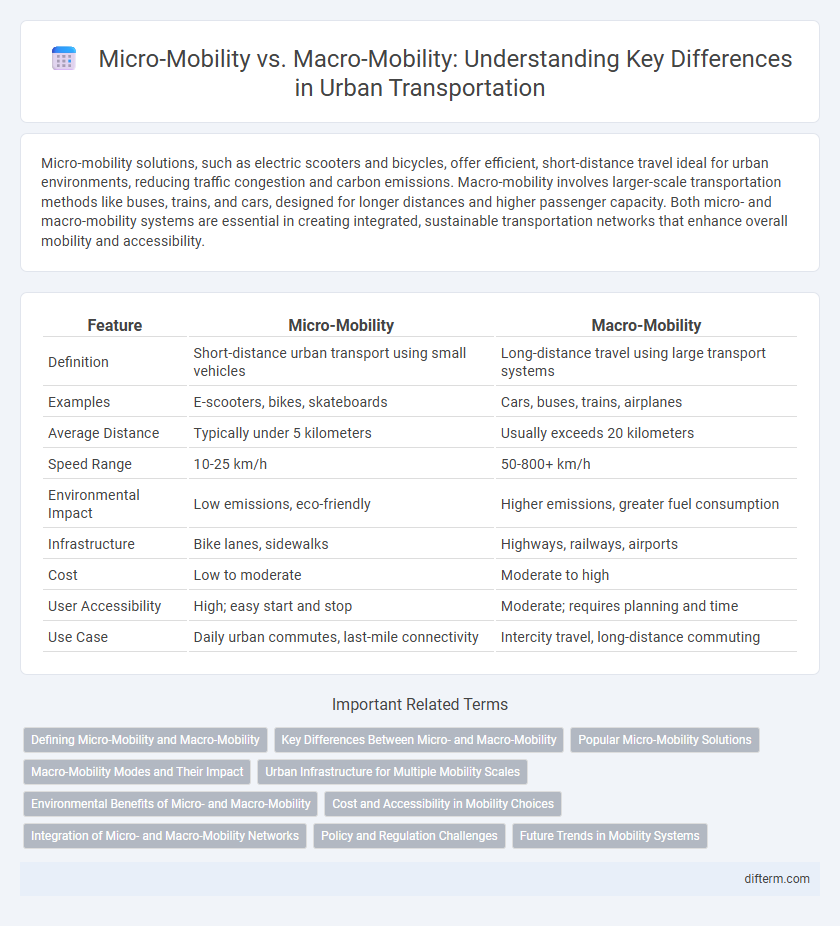Micro-mobility solutions, such as electric scooters and bicycles, offer efficient, short-distance travel ideal for urban environments, reducing traffic congestion and carbon emissions. Macro-mobility involves larger-scale transportation methods like buses, trains, and cars, designed for longer distances and higher passenger capacity. Both micro- and macro-mobility systems are essential in creating integrated, sustainable transportation networks that enhance overall mobility and accessibility.
Table of Comparison
| Feature | Micro-Mobility | Macro-Mobility |
|---|---|---|
| Definition | Short-distance urban transport using small vehicles | Long-distance travel using large transport systems |
| Examples | E-scooters, bikes, skateboards | Cars, buses, trains, airplanes |
| Average Distance | Typically under 5 kilometers | Usually exceeds 20 kilometers |
| Speed Range | 10-25 km/h | 50-800+ km/h |
| Environmental Impact | Low emissions, eco-friendly | Higher emissions, greater fuel consumption |
| Infrastructure | Bike lanes, sidewalks | Highways, railways, airports |
| Cost | Low to moderate | Moderate to high |
| User Accessibility | High; easy start and stop | Moderate; requires planning and time |
| Use Case | Daily urban commutes, last-mile connectivity | Intercity travel, long-distance commuting |
Defining Micro-Mobility and Macro-Mobility
Micro-mobility refers to small, lightweight vehicles such as electric scooters, bikes, and skateboards designed for short-distance urban travel typically under 5 miles. Macro-mobility involves larger transportation modes like cars, buses, and trains that facilitate longer-distance travel and connect broader geographic areas. Understanding these distinctions helps optimize urban planning, reduce traffic congestion, and enhance sustainable transportation systems.
Key Differences Between Micro- and Macro-Mobility
Micro-mobility involves short-distance, lightweight transportation modes such as e-scooters, bicycles, and electric skateboards primarily used for urban first- and last-mile connectivity. Macro-mobility encompasses long-distance, larger-scale transportation systems like trains, buses, and cars designed for intercity or regional travel with higher speed and capacity. Key differences include vehicle size, travel range, infrastructure requirements, and environmental impact, where micro-mobility offers greater flexibility and sustainability in congested urban areas compared to macro-mobility's emphasis on high-capacity transit.
Popular Micro-Mobility Solutions
Popular micro-mobility solutions include electric scooters, shared bicycles, and e-bikes, which provide efficient, eco-friendly alternatives for short urban trips under 5 kilometers. These options address first- and last-mile connectivity, reducing traffic congestion and emissions compared to macro-mobility methods like private cars and public transit. Growing adoption in cities worldwide highlights their role in sustainable urban transportation ecosystems.
Macro-Mobility Modes and Their Impact
Macro-mobility modes, including cars, buses, trains, and airplanes, significantly influence urban planning, environmental sustainability, and economic development by facilitating long-distance travel and mass transit. These modes enable efficient movement across cities and countries but contribute to higher carbon emissions and traffic congestion compared to micro-mobility options. Investments in electric buses, high-speed rail, and intermodal transport systems are critical to mitigating environmental impact while enhancing accessibility and connectivity in macro-mobility networks.
Urban Infrastructure for Multiple Mobility Scales
Urban infrastructure designed for multiple mobility scales integrates micro-mobility solutions such as e-scooters and bicycles with macro-mobility systems like buses and trams to enhance connectivity and reduce congestion. Dedicated lanes, charging stations, and adaptable traffic management support seamless transitions between individual and public transport modes. Smart city technologies enable real-time data sharing and dynamic route optimization, promoting efficient use of space and sustainable urban mobility.
Environmental Benefits of Micro- and Macro-Mobility
Micro-mobility, including e-scooters and bicycles, significantly reduces urban carbon emissions by offering efficient, low-energy alternatives to traditional vehicles, cutting greenhouse gases by up to 60% per trip. Macro-mobility solutions like electric buses and trains complement these benefits by enabling high-capacity, sustainable transit over longer distances, lowering overall fossil fuel consumption and air pollution. Integrating both mobility types accelerates the shift toward eco-friendly transportation networks and supports climate action goals.
Cost and Accessibility in Mobility Choices
Micro-mobility options such as e-scooters and bike-sharing systems offer significantly lower costs compared to macro-mobility modes like cars and public transit, making them more accessible for short-distance urban travel. These smaller-scale solutions reduce barriers to entry with affordable pricing and flexible usage, catering especially to commuters in dense metropolitan areas. Macro-mobility, while essential for longer distances, often involves higher expenses related to fuel, maintenance, and infrastructure, limiting accessibility for low-income populations.
Integration of Micro- and Macro-Mobility Networks
Integrating micro-mobility options such as e-scooters and bike-sharing with macro-mobility systems like buses and trains enhances urban transportation efficiency and reduces congestion. Seamless connections between first-mile/last-mile micro-mobility and long-distance macro-mobility networks increase accessibility and encourage sustainable travel habits. Smart city initiatives leverage real-time data and interoperable platforms to optimize route planning and service coordination across both mobility modes.
Policy and Regulation Challenges
Micro-mobility solutions, such as e-scooters and bike-sharing, face complex regulatory challenges including safety standards, parking restrictions, and integration with public transit systems, demanding adaptive local policies. Macro-mobility, involving cars, buses, and trains, requires comprehensive zoning laws, emission regulations, and infrastructure investments aligned with urban development plans. Policymakers must address these differing mobility scales through coordinated frameworks that balance innovation, public safety, and environmental sustainability.
Future Trends in Mobility Systems
Micro-mobility solutions such as e-scooters and bike-sharing systems are increasingly integrated with macro-mobility options like buses and trains through smart, multimodal platforms, enhancing urban mobility efficiency and reducing carbon emissions. Future trends emphasize seamless connectivity powered by AI-driven mobility-as-a-service (MaaS) systems that optimize route planning and vehicle utilization in real time. Investment in electrification, shared infrastructure, and 5G-enabled IoT ecosystems will further accelerate the convergence of micro and macro-mobility, shaping sustainable, adaptive transportation networks.
micro-mobility vs macro-mobility Infographic

 difterm.com
difterm.com